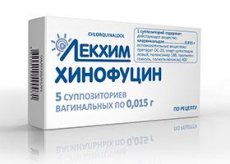Medical expert of the article
New publications
Preparations
Quinofucine
Last reviewed: 03.07.2025

All iLive content is medically reviewed or fact checked to ensure as much factual accuracy as possible.
We have strict sourcing guidelines and only link to reputable media sites, academic research institutions and, whenever possible, medically peer reviewed studies. Note that the numbers in parentheses ([1], [2], etc.) are clickable links to these studies.
If you feel that any of our content is inaccurate, out-of-date, or otherwise questionable, please select it and press Ctrl + Enter.

Hinofucin is used in gynecology. It belongs to the category of antiseptics and antimicrobial drugs.
Indications Quinofucine
It is used in the treatment of vulvovaginitis or colpitis of non-specific bacterial or fungal origin.
Release form
It is produced in the form of vaginal suppositories. One blister contains 5 suppositories. Inside the pack there are 1 or 2 blister plates.
Pharmacodynamics
The suppositories have antifungal properties and act on ascomycetes from the Aspergillus and Penicillium families, on yeast and yeast-like fungi (Candida albicans, etc.), and in addition on dermatophytes.
Hinofucin has an antibacterial effect and acts against gram-negative and gram-positive microbes (Streptococcus pyogenes, Staphylococcus aureus, Pseudomonas aeruginosa, Proteus vulgaris, Corynebacterium diphtheriae, Salmonella and Escherichia coli), and also against certain protozoa (dysenteric amoeba, Trichomonas vaginalis and Giardia lamblia).
The drug has a moderate hyperosmolar activity, which allows it to absorb vaginal secretions.
Pharmacokinetics
Chlorquinaldol is not absorbed after vaginal administration and therefore does not have resorptive properties.
Dosing and administration
The medicine is used by adult women - suppositories are inserted vaginally, 1 piece per day for 20 days, or 1 suppository twice per day for 10 days.
Before insertion, the suppository must be moistened in water. The course of treatment must begin with the onset of the menstrual cycle.
 [ 1 ]
[ 1 ]
Use Quinofucine during pregnancy
Since there is a risk of developing systemic reactions, the use of suppositories during pregnancy or lactation is permitted only in cases where the probable benefit from their use is higher than the possibility of complications in the fetus/child.
Contraindications
Contraindications: hypersensitivity to chlorquinaldol or other components of the drug. Also, suppositories are not used for children, since there is no clinical data on such use.
Side effects Quinofucine
Allergic reactions may develop, including itching and rashes on the genitals, as well as contact dermatitis (due to the action of cetostearyl alcohol). Side effects at the injection site may also occur - irritation (due to the action of propylene glycol) or burning.
Storage conditions
Hinofucin is stored in places inaccessible to small children. The temperature conditions are no more than 25°C.
 [ 2 ]
[ 2 ]
Shelf life
Hinofucin is suitable for use for a period of 3 years from the date of manufacture of suppositories.
Attention!
To simplify the perception of information, this instruction for use of the drug "Quinofucine" translated and presented in a special form on the basis of the official instructions for medical use of the drug. Before use read the annotation that came directly to medicines.
Description provided for informational purposes and is not a guide to self-healing. The need for this drug, the purpose of the treatment regimen, methods and dose of the drug is determined solely by the attending physician. Self-medication is dangerous for your health.

